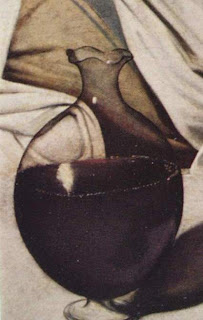Monday, November 2nd, 2009
New Portrait of Caravaggio (Only You Can’t See It)

If I asked you what was in this detail of Caravaggio’s Bacchus (1597), and you answered “A carafe of wine,” you would only be given partial-credit for your answer. Sorry. This detail, my friends, has been found to contain an early self-portrait of Caravaggio at his easel, shown as a reflection in the glass carafe.
You’re aren’t seeing it, you say? To tell you the truth, me neither. In actuality, you can’t see this detail with the naked eye. It used to be visible, however, since it was mentioned by an Italian restorer in 1922. However, poor restoration efforts and the gradual darkening of this image have obscured this small portrait over time. Only recently did the portrait “resurface” through reflectography, and the image results were revealed last Friday at a conference in Florence.
You can kinda-sorta see the portrait of Caravaggio in this Telegraph article, which posted the reflectography results and circled where the portrait is located. I’m still not seeing too much, but I’m trusting that one can actually see a young Caravaggio, paintbrush in hand, with his arm extended toward a canvas on an easel.
Pretty cool, huh? I wonder if restorative efforts can make this self-portrait visible again to the naked eye.
fie on restorers!
That is pretty cool. How like Caravaggio to include some obscure self portrait. Did he do any paintings where he didn't include references to himself?
I can kinda see it in the article's picture. That is a seriously tiny self-portrait, though! I wonder if Caravaggio was a fan of Dutch Masters?
I could kind of sort of barely see it on the article, but I mean, BARELY. Still, it's a pretty cool thing nonetheless. I like that the artist was being tricky.
Thank you for becoming one of the followers of my blog. I am now one of your followers as well and look forward to your posts. Re Caravaggio's painting, I stood in front of it and used my husband's (very powerful) binoculars to get a really close look at the carafe (the painting was on an easel and cordoned off) and I couldn't see it either.
L
Yeah, Kiersten, there are paintings by Caravaggio that don't include references to himself. Some of his religious paintings, like Death of the Virgin (1604-1606) and The Conversion of St. Paul (1600-1601) don't appear to include a self-portrait. At least, not one that is visible! Who knows? Maybe there more self-portraits that can be seen with reflectography!
I don't know if Caravaggio was a fan of the Dutch Masters, heidenkind. It seems more likely that the Northerners were the ones who were influenced by Caravaggio (take the Utrecht Caravaggisti, for example). However, I've wondered if Caravaggio might have been influenced by Northern Renaissance arti, like the self-portraits that Jan van Eyck included in his paintings.
I did have some thoughts similar to yours, though. After learning about this self-portrait of Caravaggio, I thought of other Baroque paintings which include reflections in glass, such as the glass orb in Vermeer's Allegory of Faith (c. 1670-1674). It's pretty obvious that Vermeer was influenced by Caravaggio's style, so perhaps this interest in glass reflection is another connection between the two artists.
Welcome to my blog, LHZ. I think it's fun that you used powerful binoculars to try and see the portrait detail. That's the mark of a good art historian! I look forward to following your posts as well.
Aha, but then question becomes, how did he encounter Dutch Renaissance art? I think I see a potential thesis topic for you, M!
Ha ha! Don't tempt me, heidenkind! 🙂
I have to admit, though, you've totally piqued my curiosity. I know that Jan van Eyck was recognized as a great master in Renaissance Italy, but I don't know if his art was still known in Italy by the time the Baroque period began. Oh man, there's a good chance that this question might keep me up at night…
Another thought on this topic: is the self-portrait of Maria van Oosterwyck (reflected in a wine flask within Still Life with a Vanitas Theme) directly (or indirectly) influenced by Caravaggio's Bacchus? I think it's possible.